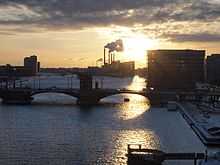Langebro
| Langebro | |
|---|---|
 | |
| Coordinates | 55°40′13.08″N 12°34′43.46″E / 55.6703000°N 12.5787389°ECoordinates: 55°40′13.08″N 12°34′43.46″E / 55.6703000°N 12.5787389°E |
| Carries | Motor vehicles, pedestrian and bicycle traffic |
| Crosses | Copenhagen Inner Harbour |
| Locale |
City Centre Islands Brygge |
| Characteristics | |
| Design | Bascule bridge |
| Total length | 250 metres (820 ft) |
| Vertical clearance | 7 metres (23 ft) |
| History | |
| Designer | Kaj Gottlob |
| Construction begin | 1949 |
| Construction end | 1954 |
Langebro is a bascule bridge across the Inner Harbour of Copenhagen, Denmark, connecting Zealand-side H. C. Andersens Boulevard to Amager-side Amager Boulevard. It is one of only two bridges to carry motor vehicles across the harbour in central Copenhagen, the other being Knippelsbro.
History
There has been a bridge called Langebro at the site since 1886 when King Christian V had a wooden bridge built. At that time the bridge connected to Langebrogade, Christianshavn and not Amager Boulevard, Amager. Since then the bridge has been remodelled and rebuilt several times. In 1903 a swing bridge was built and used for both trams and the Amagerbanen railroad. At the same event the eastern bridge end was moved from Langebrogade to Amager Boulevard. With growing automobile traffic, the new bridge soon became outdated and a new temporary bridge was constructed in 1930. It was replaced by the current Langebro in 1954.[1]
Cultural references
- Langebro is a play by Hans Christian Andersen, named for the bridge in Copenhagen.[2]
- Scenes from a panick-stricken Langebro is featured in the Danish-American 1961 giant monster film Reptilicus about a giant prehistoric reptile which is regenerated from a tail section and goes on am unstoppable rampage through Copenhagen before it is finally killed by poison by an ingenious scientists and military officers.[3]
- "Langebro" is the name of Gasolin's 1971 adaption of Joan Baez's version of Geordie, where the setting is shifted from London to Copenhagen and Langebro takes the place of London Bridge.[4]
References
- ↑ "Langebro". Selskabet for Københavns Historie. Retrieved 2009-11-12.
- ↑ "H.C. Andersen : Langebro". H. C. Andersen Centret. Retrieved 2009-11-12.
- ↑ "Reptilicus, 1961". plaschicke.dk. Retrieved 2009-11-12.
- ↑ "Reptilicus, 1961". DVM. Retrieved 2009-11-12.